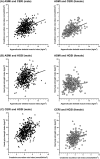Muscle mass, muscle strength and mortality in kidney transplant recipients: results of the TransplantLines Biobank and Cohort Study
- PMID: 36891995
- PMCID: PMC9745460
- DOI: 10.1002/jcsm.13070
Muscle mass, muscle strength and mortality in kidney transplant recipients: results of the TransplantLines Biobank and Cohort Study
Abstract
Background: Survival of kidney transplant recipients (KTR) is low compared with the general population. Low muscle mass and muscle strength may contribute to lower survival, but practical measures of muscle status suitable for routine care have not been evaluated for their association with long-term survival and their relation with each other in a large cohort of KTR.
Methods: Data of outpatient KTR ≥ 1 year post-transplantation, included in the TransplantLines Biobank and Cohort Study (ClinicalTrials.gov Identifier: NCT03272841), were used. Muscle mass was determined as appendicular skeletal muscle mass indexed for height2 (ASMI) through bio-electrical impedance analysis (BIA), and by 24-h urinary creatinine excretion rate indexed for height2 (CERI). Muscle strength was determined by hand grip strength indexed for height2 (HGSI). Secondary analyses were performed using parameters not indexed for height2. Cox proportional hazards models were used to investigate the associations between muscle mass and muscle strength and all-cause mortality, both in univariable and multivariable models with adjustment for potential confounders, including age, sex, body mass index (BMI), estimated glomerular filtration rate (eGFR) and proteinuria.
Results: We included 741 KTR (62% male, age 55 ± 13 years, BMI 27.3 ± 4.6 kg/m2), of which 62 (8%) died during a median [interquartile range] follow-up of 3.0 [2.3-5.7] years. Compared with patients who survived, patients who died had similar ASMI (7.0 ± 1.0 vs. 7.0 ± 1.0 kg/m2; P = 0.57), lower CERI (4.2 ± 1.1 vs. 3.5 ± 0.9 mmol/24 h/m2; P < 0.001) and lower HGSI (12.6 ± 3.3 vs. 10.4 ± 2.8 kg/m2; P < 0.001). We observed no association between ASMI and all-cause mortality (HR 0.93 per SD increase; 95% confidence interval [CI] [0.72, 1.19]; P = 0.54), whereas CERI and HGSI were significantly associated with mortality, independent of potential confounders (HR 0.57 per SD increase; 95% CI [0.44, 0.81]; P = 0.002 and HR 0.47 per SD increase; 95% CI [0.33, 0.68]; P < 0.001, respectively), and associations of CERI and HGSI with mortality remained independent of each other (HR 0.68 per SD increase; 95% CI [0.47, 0.98]; P = 0.04 and HR 0.53 per SD increase; 95% CI [0.36, 0.76]; P = 0.001, respectively). Similar associations were found for unindexed parameters.
Conclusions: Higher muscle mass assessed by creatinine excretion rate and higher muscle strength assessed by hand grip strength are complementary in their association with lower risk of all-cause mortality in KTR. Muscle mass assessed by BIA is not associated with mortality. Routine assessment using both 24-h urine samples and hand grip strength is recommended, to potentially target interdisciplinary interventions for KTR at risk for poor survival to improve muscle status.
Keywords: bio‐electrical impedance analysis; hand grip strength; kidney transplant; mortality; muscle mass; muscle strength.
© 2022 The Authors. Journal of Cachexia, Sarcopenia and Muscle published by John Wiley & Sons Ltd on behalf of Society on Sarcopenia, Cachexia and Wasting Disorders.
Conflict of interest statement
The authors declare no conflicts of interest.
Figures


References
-
- Tonelli M, Wiebe N, Knoll G, Bello A, Browne S, Jadhav D, et al. Systematic review: kidney transplantation compared with dialysis in clinically relevant outcomes. Am J Transplant 2011;11:2093–2109. - PubMed
-
- Oterdoom LH, de Vries AP, van Ree RM, Gansevoort RT, van Son WJ, van der Heide JJ, et al. N‐terminal pro‐B‐type natriuretic peptide and mortality in renal transplant recipients versus the general population. Transplantation 2009;87:1562–1570. - PubMed
-
- Hoogeveen EK, Aalten J, Rothman KJ, Roodnat JI, Mallat MJ, Borm G, et al. Effect of obesity on the outcome of kidney transplantation: a 20‐year follow‐up. Transplantation 2011;91:869–874. - PubMed
Publication types
MeSH terms
Substances
Associated data
LinkOut - more resources
Full Text Sources
Medical
Research Materials
Miscellaneous

